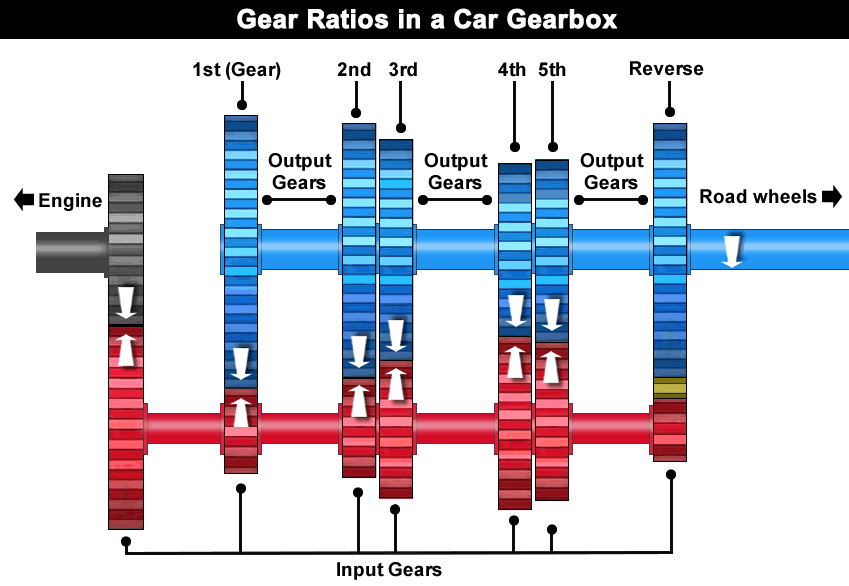Car Gear Ratios Explained
Detailed on this page is a simplified explanation of a car’s gear ratios based on a typical 5 speed manual gearbox.
Car Gear Ratios Explained
A car’s engine operates within a certain range of speed. If a car didn’t have gears, you would only be able to move at the speed of the engine. This would make moving off from a standstill very difficult and without gears, the top speed would be slower.

Different size cogs inside the gearbox provide different gear ratios. As an example, in a gearbox with 5 forward gears, all gears (1 to 5) operate on the same principle; a cog is connected to the engine side called the input gear and a cog connected to the road wheels side is called the output gear.
For 1st gear, the input gear is much smaller than the output gear and this provides the gear with the highest ratio. With this ratio, the engine rotates many more times compared to the road wheels and this provides the highest amount of power (torque); ideal for moving off from a standstill but not very good for speed.
5th gear is the opposite; less pulling power (torque) is required because the car has momentum and so we trade torque for speed. The input gear is larger than the output gear and this provides the lowest gear ratio.
How Are Gear Ratios Worked Out?
Let’s look at the gear ratio of a 5 speed manual gearbox. Gear ratios aren’t usually quite as exact as these, but it makes understanding it a little easier.
| Gear | Ratio |
|---|---|
| 1st Gear | 3.00:1 |
| 2nd Gear | 2.00:1 |
| 3rd Gear | 1.50:1 |
| 4th Gear | 1.00:1 |
| 5th Gear | 0.50:1 |
Gear ratios are worked out by dividing the number of teeth on the input gear (or cog), by the number of teeth on the output gear. On low gears such as 1st and 2nd, the output gears are larger and have more teeth on them when compared to the input gear that they’re meshed to, meaning the output gears rotate slower.
As we know, the input gear is driven by the engine and the output gear determines the speed in which the road wheels rotate. So based on the gear ratios above:
1st Gear
In 1st gear, the engine makes 3.00 revolutions for every one revolution of the transmission’s output gear. This is because the output gear is bigger and has 3 times the amount of teeth than the input gear.
2nd Gear
In 2nd gear, the engine makes 2.00 revolutions for every one revolution of the transmission’s output gear. This is because the output gear is bigger and has 2 times the amount of teeth than the input gear.
4th Gear
In 4th gear, the gear ratio of 1:1 and with the input and output gears being the same size, it means that the engine and the transmission’s output rotate at the same speed. Both input and output gears have the same amount of teeth.
5th Gear
In 5th gear, the engine’s revolutions are half that of the output gear. The output gear is smaller and is rotating faster than the input gear – ideal for high speed. The output gear is smaller and has fewer teeth than the input gear.
Very informative and straightforward explanation – thank you!
yw
Nice explanation.
Thanks for explanation
Hi Buddhika,
No problem.
In some articles, gear ratios are often used to describe gears like they’re actually a size thing or measurement. Kinda confusing.
If 1st gears are commonly low gears, then why are they of highest ratio as described above? Aren’t they supposed to be of lowest ratio? That’s why they’re called low gear in the first place, aren’t they?
I guess it’s just a matter of which ratio one happens to choose? meaning if one chooses to use the number of Output teeth over the number of Input teeth (O/I) then you have a high ratio (for 1st gear), right? But if I over O is chosen, it then gives a low ratio for the same 1st gear. Which should be the case, right? Low gears have low ratios, high gears have high ratios? for consistency.